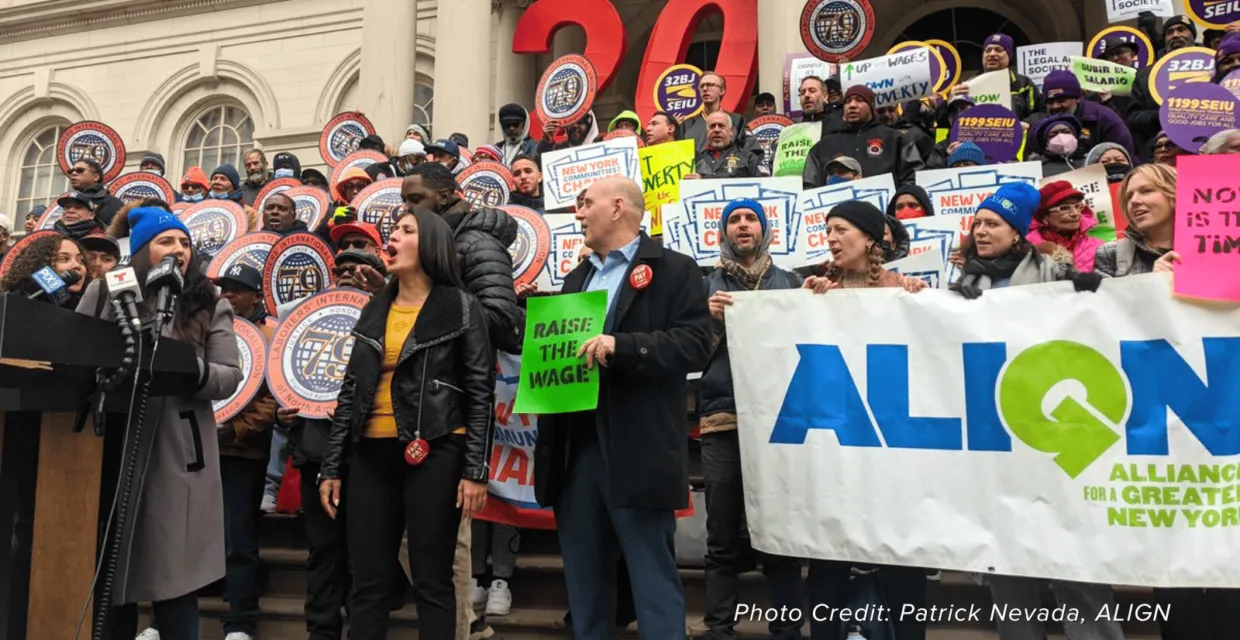
This blog was produced in collaboration with the Economic Policy Institute.
This “off-ramp” provision must be repealed
In a public opinion poll released earlier this year, more than two-thirds of New York voters expressed a belief that workers need to earn at least $20 an hour to live at a decent level. In response, a worker-led campaign, Raise Up New York, advocated for a $21.25 minimum wage in the Empire State.
Yet, despite overwhelming public support for a significant minimum wage raise, New York Governor Kathy Hochul demanded that the state legislature slash the target rate under consideration by more than $4 an hour, and she ultimately signed into law an inadequate minimum wage of just $16 by 2026 in upstate New York and $17 downstate. In addition, the law includes a dangerous “off-ramp” provision that could freeze any increase to the state’s minimum wage starting in 2027.
As a result, New York’s minimum wage will be lower in inflation-adjusted dollars in 2026 than it was in 2019. In fact, the purchasing power of New York’s minimum wage has already dropped 15% since 2018, and it’s expected to fall another 15% by 2026. Gov. Hochul’s minimum wage target is undeniably weak compared with other high cost-of-living areas in the United States. Twenty-two jurisdictions already have minimum wages at or above $17 an hour, including Seattle ($18.69), SeaTac ($19.06), and Tukwila ($18.99) in Washington state; Denver, CO ($17.29); Washington, D.C. ($17.00); and 17 cities in California.[1] All these jurisdictions make annual changes to their minimum wage to account for price increases. New York’s minimum wage is also likely to eventually be exceeded by Hawaii’s ($16.00 in 2026 and $18.00 in 2028). These jurisdictions are implementing much greater and more impactful minimum wage increases than New York to protect the value of underpaid workers’ wages against rising costs.
Worse, Gov. Hochul also demanded and signed into law a harmful “off-ramp” provision that needlessly undermines the protection of the state minimum wage and threatens to allow workers’ wages to fall farther and farther behind inflation. Starting in 2027, New York’s minimum wage would automatically freeze if unemployment slightly ticks up or employment slightly drops. The unemployment off-ramp provision is triggered if the New York seasonally adjusted three-month average unemployment rate from May to July is at least half a percentage point higher than the lowest (three-month average) unemployment rate of the previous 12 months. The employment provision freezes the minimum wage increase if the seasonally adjusted non-farm employment in New York state decreases from July to January and from April to July.
These conditions occur with enough frequency to have been observed 25% of the time over the last 23 years, and we should be wary of these circumstances reoccurring soon. The United States currently has a historically tight labor market, where there are more job openings than unemployed workers.
A modest increase in the unemployment rate could still reflect an otherwise healthy economy; in fact, the unemployment rate can sometimes rise for good reasons if strong job opportunities encourage previously discouraged or disinterested workers into the labor market. Yet the enacted off-ramp would still automatically stop any increases in the minimum wage even in such circumstances. In 2027, economic conditions will be different than at present. There is no justification for letting the paychecks of workers earning the minimum wage erode at the slightest change in the labor market.
The practical implications of an off-ramp would be devastating for New Yorkers at the bottom of the wage distribution. We estimate that if the off-ramp provision was triggered in 2027, 1.45 million low-wage New York workers would lose out on a wage increase.
The practical implications of an off-ramp would be devastating for New Yorkers at the bottom of the wage distribution. We estimate that if the off-ramp provision was triggered in 2027, 1.45 million low-wage New York workers would lose out on a wage increase. In total, the off-ramp would cost these workers $609 million (in 2022 dollars) in earnings. Furthermore, under the new minimum wage law, inflation-based adjustments to the minimum wage could be frozen up to two consecutive years, meaning that in 2028 workers could lose out on hundreds of millions more in potential wage increases.
Off-ramps not only hurt workers, but they are completely unnecessary. Sixteen of the 19 states with minimum wage policies that index to inflation, and almost all the 60+ cities and counties with local minimum wage policies, do not have these harmful provisions.
These states, cities, and counties (including New York state) have kept raising their wage floors at the pace of inflation through the pandemic when unemployment ticked up, and there is no indication that this hurt their economies or impacted their job growth. To the contrary, minimum wage increases can serve as an economic stimulus during a downturn, and can help speed up a recovery.
Freezing minimum wage increases simply because the unemployment rate slightly rises makes no sense. The near-consensus among minimum wage researchers is that minimum wage policies boost the incomes of affected workers without leading to meaningful employment losses.
In fact, a recent study finds that not only do minimum wage policies raise the incomes of affected workers without job losses, they might also lead to higher employment. Research also finds that raising the minimum wage positively impacts other aspects of the lives of workers and their families. For example, robust wage floors are also associated with better health and educational outcomes for workers and their families.
The New York legislature and the governor have the responsibility to ensure all New Yorkers are paid a living wage.
The New York legislature and the governor have the responsibility to ensure all New Yorkers are paid a living wage. At a minimum, in the short term, they need to repeal the harmful and unnecessary off-ramp freeze provision from New York’s minimum wage law, and over the longer term they should enact a more meaningful minimum wage increase that ensures that all New Yorkers earn a living wage.
Endnotes
[1] Berkeley ($18.07), Cupertino ($17.20), El Cerrito ($17.35), Emeryville ($18.67), Los Altos ($17.20), Milpitas ($17.20), Mountain View ($18.15), Palo Alto ($17.25), Petaluma ($17.06), Redwood City ($17.00), San Francisco ($18.07), San Jose ($17.00), Santa Clara ($17.20), Santa Rosa ($17.06), Sonoma ($17.00), Sunnyvale ($17.95), and West Hollywood ($19.08).




